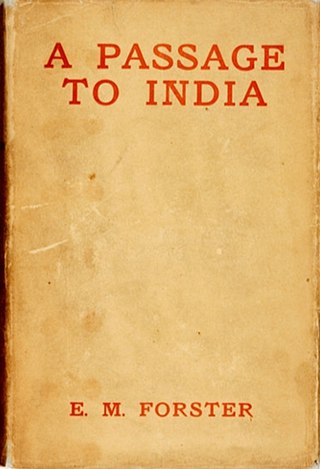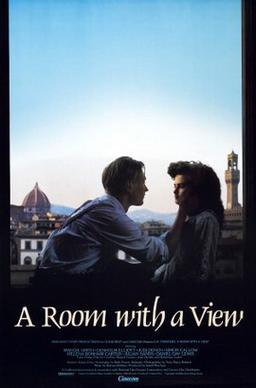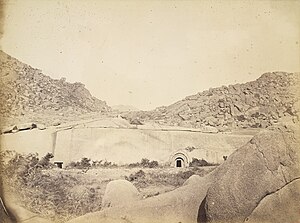
Edward Morgan Forster was an English author, best known for his novels, particularly A Room with a View (1908), Howards End (1910) and A Passage to India (1924).

A Passage to India is a 1924 novel by English author E. M. Forster set against the backdrop of the British Raj and the Indian independence movement in the 1920s. It was selected as one of the 100 great works of 20th century English literature by the Modern Library and won the 1924 James Tait Black Memorial Prize for fiction. Time magazine included the novel in its "All Time 100 Novels" list. The novel is based on Forster's experiences in India, deriving the title from Walt Whitman's 1870 poem "Passage to India" in Leaves of Grass.

Maurice is a novel by E. M. Forster. A tale of homosexual love in early 20th-century England, it follows Maurice Hall from his schooldays through university and beyond. It was written in 1913–1914 and revised in 1932 as well as 1952–1960. Forster was an admirer of the poet, philosopher, socialist, and early gay rights activist Edward Carpenter and, following a visit to Carpenter's home at Millthorpe, Derbyshire in 1913, was inspired to write Maurice. The cross-class relationship between Carpenter and his working-class partner, George Merrill, presented a real-life model for that of Maurice and Alec Scudder.
"The Machine Stops" is a science fiction short story by E. M. Forster. After initial publication in The Oxford and Cambridge Review, the story was republished in Forster's The Eternal Moment and Other Stories in 1928. After being voted one of the best novellas up to 1965, it was included that same year in the populist anthology Modern Short Stories. In 1973 it was also included in The Science Fiction Hall of Fame, Volume Two.

Ajivika is one of the nāstika or "heterodox" schools of Indian philosophy. Believed to have been founded in the 5th century BCE by Makkhali Gosāla, it was a Śramaṇa movement and a major rival of Vedic religion, early Buddhism, and Jainism. Ājīvikas were organized renunciates who formed discrete communities. The precise identity of the Ājīvikas is not well known, and it is even unclear if they were a divergent sect of the Buddhists or the Jains.

Howards End is a novel by E. M. Forster, first published in 1910, about social conventions, codes of conduct and relationships in turn-of-the-century England. Howards End is considered by many to be Forster's masterpiece. The book was conceived in June 1908 and worked on throughout the following year; it was completed in July 1910.

A Passage to India is a 1984 epic historical drama film written, directed and edited by David Lean. The screenplay is based on the 1960 play of the same name by Santha Rama Rau, which was in turn based on the 1924 novel of the same name by E. M. Forster.

A Room with a View is a 1985 British romance film directed by James Ivory and produced by Ismail Merchant. It is written by Ruth Prawer Jhabvala, who adapted E. M. Forster's 1908 novel A Room with a View. Set in England and Italy, it is about a young woman named Lucy Honeychurch in the final throes of the restrictive and repressed culture of Edwardian England and her developing love for a free-spirited young man, George Emerson. Maggie Smith, Denholm Elliott, Daniel Day-Lewis, Judi Dench and Simon Callow feature in supporting roles. The film closely follows the novel by the use of chapter titles to distinguish thematic segments.

Syed Sir Ross Masood bin Mahmood Khan, was the Vice-Chancellor of Aligarh Muslim University starting in 1929.

Indian rock-cut architecture is more various and found in greater abundance in that country than any other form of rock-cut architecture around the world. Rock-cut architecture is the practice of creating a structure by carving it out of solid natural rock. Rock that is not part of the structure is removed until the only rock left makes up the architectural elements of the excavated interior. Indian rock-cut architecture is mostly religious in nature.

The Barabar Hill Caves are the oldest surviving rock-cut caves in India, dating from the Maurya Empire, some with Ashokan inscriptions, located in the Makhdumpur region of Jehanabad district, Bihar, India, 24 km (15 mi) north of Gaya.

Amira Masood is a fictional character from the BBC soap opera EastEnders, played by Preeya Kalidas. The girlfriend, and later wife, of Syed Masood, Amira first appeared on screen in the episode broadcast on 7 May 2009. The character was described as high maintenance, lonely and insecure. Amira and Syed's wedding on 1 January 2010 was watched by an average of 11.64 million viewers. Kalidas quit the show in January 2010 to concentrate on a career in music, filming her final scenes in March 2010. Her final episode was broadcast on 26 April 2010, after Amira discovered that her husband was gay and had been having an affair with Christian Clarke. She returned on EastEnders on 10 October 2011, but appeared in two extra scenes available on BBC Online and BBC Red Button called Amira's Secret, on 6 and 8 September 2011. The character departed on 8 March 2012. On 11 September 2012, it was confirmed that Kalidas would return to play Amira once more in a brief guest appearance, in the buildup to the permanent departure of Syed and Christian from the show. She returned on 6 November 2012, and departed once more on 12 November 2012.
Bankipur is a neighbourhood and residential area in Patna, in the Indian state of Bihar. It is located on the bank of the river Ganges. The prime attraction is the Khuda Bakhsh Oriental Library built by Khan Bahadur Khuda Bakhsh in 1891 and Golghar granary that was built by Captain John Garstin in 1786. Patna Dental College and Hospital is also located here.

Patna College is a constituent state aided College of Patna University which was established in 1863 during the British Raj. It offers undergraduate and postgraduate courses in science, arts and commerce as well as some vocational courses like BBA, BMC and BCA. The college is affiliated to Patna University. It is also considered to be the oldest institution of higher education in Bihar.

The Lomas Rishi Cave, also called the Grotto of Lomas Rishi, is one of the man-made Barabar Caves in the Barabar and Nagarjuni hills of Jehanabad district in the Indian state of Bihar. This rock-cut cave was carved out as a sanctuary. It was built during the Ashokan period of the Maurya Empire in the 3rd century BC, as part of the sacred architecture of the Ajivikas, an ancient religious and philosophical group of India that competed with Jainism and became extinct over time. Ājīvikas were atheists and rejected ritualism of the Puranic karma Kāṇḍa as well as Buddhist ideas. They were ascetic communities and meditated in the Barabar caves. Still, the Lomas Rishi cave lacks an explicit epigraphical dedication to the Ajivikas, contrary to most other Barabar Caves, and may rather have been built by Ashoka for the Buddhists.
A Passage to India is a stage play written by Indian-American playwright Santha Rama Rau (1923–2009), based on E.M. Forster's 1924 novel of the same name.
Bankipore Club is a social club in Patna and is one of the oldest clubs of India and second oldest in East India after Calcutta Rowing Club. It was founded in 1865 during the British Raj. The club is located in Bankipore neighbourhood of Patna.

The Buddhist caves in India. Maharashtra state Aurangabad Dist. Ellora caves form an important part of Indian rock-cut architecture, and are among the most prolific examples of rock-cut architecture around the world. There are more than 1,500 known rock cut structures in India, out of which about 1000 were made by Buddhists, 300 by Hindus, and 200 by Jains. Many of these structures contain works of art of global importance, and many later caves from the Mahayana period are adorned with exquisite stone carvings. These ancient and medieval structures represent significant achievements of structural engineering and craftsmanship.

Raqeeb Se is a Pakistani romantic drama television series produced by Momina Duraid, written by Bee Gul and directed by Kashif Nisar. It aired on Hum TV from 20 January 2021 to 26 May 2021 all under MD Productions. Raqeeb Se revolves around the repercussions of a love story stretched around one's entire life. It features an ensemble cast of Hadiqa Kiani, Nauman Ijaz, Sania Saeed, Iqra Aziz, Faryal Mehmood and Saqib Sumeer.

The Unknown Bridesmaid is a 2013 novel by English novelist Margaret Forster published by Chatto & Windus.
















